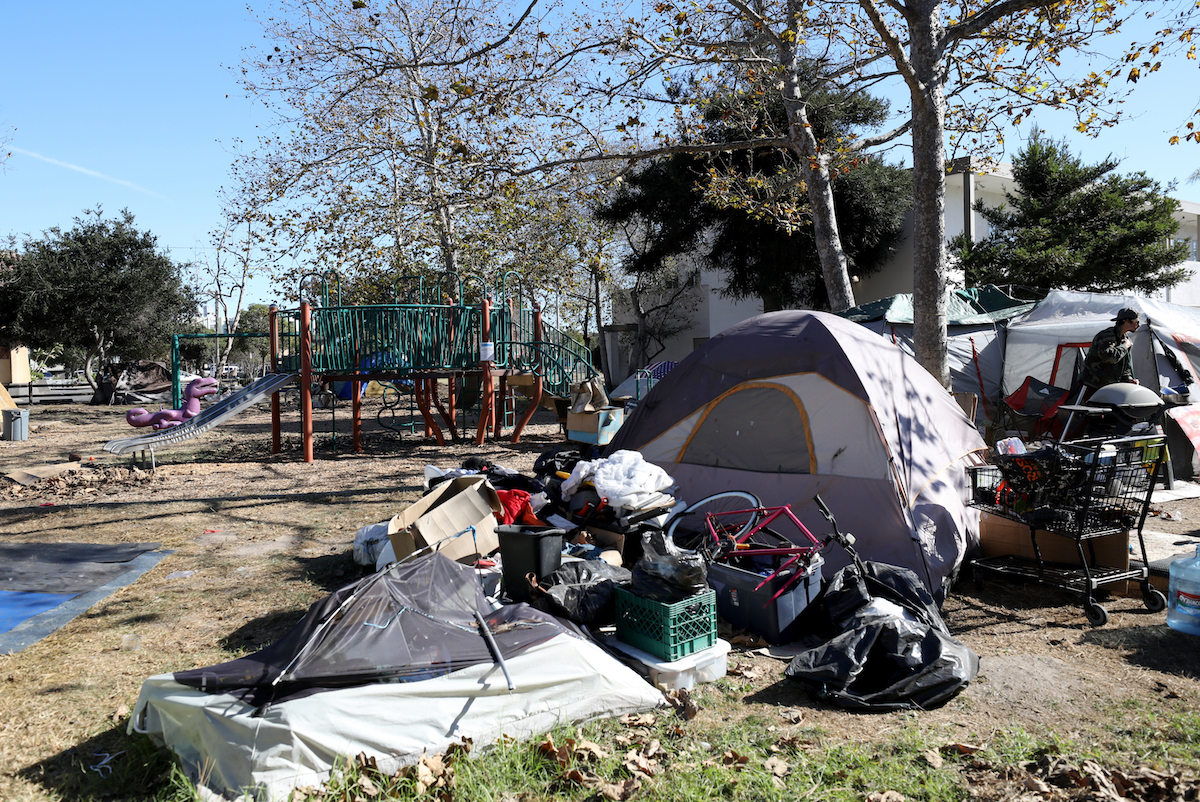Tent Cities as Hedge Against Future Fires?
In Wake of Loma Fire, City Council to Hold Emergency Meeting on Relocating Homeless Encampments

Last Thursday night’s Loma Fire — which erupted fast and furious along the steep and treacherous hillside running up from Loma Alta Road to Miramonte Drive, better known as TV Hill, consuming nearly 10 acres and damaging two homes along the way — was declared 100 percent contained by the Santa Barbara City Fire Department Monday afternoon. Even though the fire was not started at a homeless encampment, the speed and ferocity with which it spread throughout a densely populated area of the city has prompted Santa Barbara City Councilmembers Michael Jordan and Eric Friedman to push for an emergency session this Tuesday evening to discuss plans to shut down encampments in high-fire-risk areas.
Crews were deployed along the hillside days after the fire — which was propelled uphill by winds reaching speeds of 55 miles per hour — searching for smoldering embers and even hot roots that might reignite, setting off another blaze. Given the intensity of prevailing winds and the dryness of the brush, the fire could have taken off in any direction with a sudden shift in direction. Downhill lay some of the most tightly packed housing within city limits, while uphill sits some of its most spectacular real estate.
During the fire itself, Loma Alta was choked not just with fire personnel from the County of Santa Barbara, Montecito, and Carpinteria, but also throngs of lookie-loos craning for a better view of the pyrotechnic bullet that public safety officials are happy to have dodged.
In the aftermath, questions are emerging as to why the region’s emergency-response system did not send out smartphone alerts to nearby residents. Instead, city police conducted door-to-door evacuation knocks. The fire was reported minutes before 9 p.m. Thursday, and based on prior experience with the hillside, fire officials reckoned it was a 45-minute trajectory to the top.
Police arrested a 23-year-old named Victor Hernandez, said to be under the influence of methamphetamine, for setting the fire. According to the police, Hernandez, currently held on $2 million bail, was a person of interest in five other fires and has been on the public safety radar since last June. Hernandez was reportedly discovered downslope from Loma Alta, and, according to police, comments Hernandez made put him at the scene of the blaze at the time it started.
With the fire now fully contained and an arson suspect in custody, the city council this Tuesday night now turns its attention to breaking up homeless encampments in an effort to prevent other blazes from erupting in fire-prone areas. To provide an alternative location for homeless individuals displaced by such cleanup efforts, the council will discuss a number of options for possible tent cities. High on the list is the public parking commuter lot by the intersection of Castillo and Carrillo Streets, which currently is slated to become what’s known as a “navigation center” for those without housing, much like the one that’s been operating every Thursday evening at Alameda Park. Such sites provide food, medical care, pet care, and mental-health assistance — among other things — to those in need.
Other sites mentioned are De la Guerra Plaza, the City Hall Parking Lot, Parking Lot 10, and the County Administration Building. Wherever the proposed pilot project landed, it would be up for no more than 120 days.
Councilmember Jordan was especially emphatic on the need for such solutions, even if the Centers for Disease Control and Prevention still insists that homeless encampments should be left alone in response to the COVID pandemic. Jordan argued that the threat posed by out-of-control urban wildfires is more immediate with the onset of high fire season, stiff winds, and what appears to be another record drought.
Any new tent city, he acknowledged, would require both security and services. Where that money will come from remains unresolved for a cash-strapped City Hall.
Because of economic losses inflicted by COVID, all city departments have been asked to make do with 5 percent less in revenues. Jordan suggested that the County of Santa Barbara — sporting a $23 million COVID-infused surplus — might be able to help. The county has been the conduit for millions in state and federal emergency funds targeting the unsheltered.
The $4 million the county had set aside to purchase the site of the former Youth Hostel located by the train depot might be available, Jordan speculated, given that the deal to purchase that property just fell through two weeks ago. In that case, the county’s offer to buy the property — which would have been used to create transitional housing — was rejected in favor of a higher bid submitted by another purchaser.
Governor Gavin Newsom’s proposed budget includes $53 million that could be used to respond to issues associated with homeless encampments, but that budget has yet to be ratified by the legislature.
Other cities have proposed tent cities to provide emergency shelter for those living in encampments with mixed results. In Santa Rosa and Sacramento, such proposals were initially met with stiff neighborhood resistance that quickly dissipated when it became evident they were well managed. In Los Angeles — where the numbers have been so intense — similar efforts in Echo Park, for example, have become poster-child examples of lose-lose propositions.
Santa Barbara City Council will hold a special hearing Tuesday night at 6 p.m. to discuss the matter.
Support the Santa Barbara Independent through a long-term or a single contribution.



